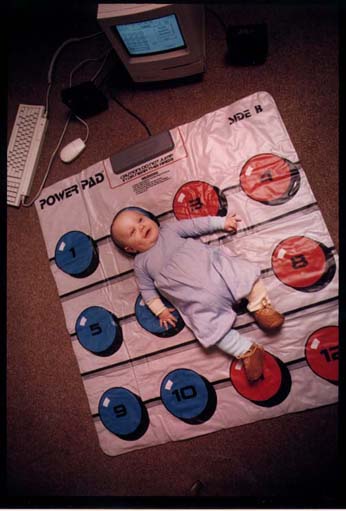The URL for this document is: http://www.ccs.neu.edu/home/fell/BBB.html

The Baby Babble Blanket (BBB) was developed by an interdisciplinary team led by:
Linda J. Ferrier, Ph.D.
Department of Speech Language Pathology and Audiology
Northeastern University, Boston, MA 02115
Phone: (617) 373-5754
ferrier@ccs.neu.edu
and
Harriet J. Fell
College of Computer Science
Northeastern University, Boston, MA 02115
Phone: (617) 373-2198
fell@ccs.neu.edu
The BBB(patent #5260869) is a multiple micro-switch-activated pad serving as input to a Macintosh computer and our software. The software allows digitized output of speech, babbles, words, sentences, music or environmental sounds, to be accessed by the switches. The BBB includes a data collection system that uses a single-case study design to evaluate the responses of infants who are otherwise difficult to test.
It will allow severely physically disabled infants to: 1) establish cause and effect skills, 2) explore a babbling repertoire like normal infants, and 3) use early motor movements to produce digitized sounds. We are testing the BBB in the home with normal infants, infants with cerebral palsy and other motorical problems, and in a school with multiply handicapped children. Data are presented on a cognitively normal five-month-old infant with poor muscle tone, club feet and hydrocephaly who used the device to hear his mother's voice.
Infants with severe motor problems, even those with apparently normal cognitive skills, frequently develop to be passive children with limited or nonexistent speech [Cerebral Palsy. Tarrytown, New York: Pergamon Press, 1986]. Seligman [Helplessness: On Depression, Development and Death. San Francisco: W. H. Freeman, 1975] has attributed this "learned helplessness," to an inability to control the environment. Other literature [Use of microswitch technology to facilitate social contingency awareness as a basis for early communication skills. In: Augmentative and Alternative Communication, 1989; 5 (3): 192-197] suggests that even severely disabled infants can learn to control their environment through the use of micro-switch technology. At later ages, these children may spend many hours on floor mats with little to engage them or any means of communicating with caregivers. While there are now many environmental and communication aids for children who can touch a screen or activate a single switch with a limb, little attention has been given so far to harnessing very early movements, such as head-rolling, to activate assistive technology. A primary goal in developing the Baby-Babble-Blanket (BBB) was to develop and test a system that would allow even the youngest infant or most severely disabled child to control the environment and communicate while in a lying position. A second goal was to include an automatic data collection system that would demonstrate that the infant was controlling the system in response to the reinforcing consequences it provided. A final goal was to use the device to improve the motor abilities of these infants.
Harriet Fell
Last Updated: November 9, 2007 5:54 p.m.
The URL for this document is:
http://www.ccs.neu.edu/home/fell/BBB.html